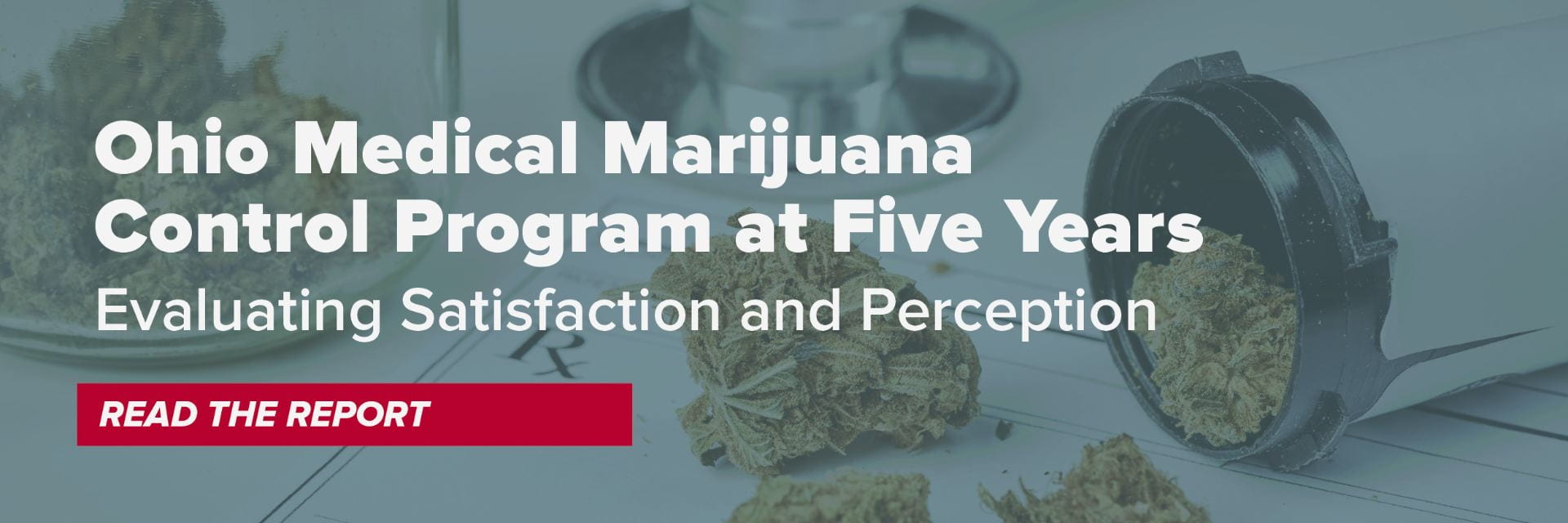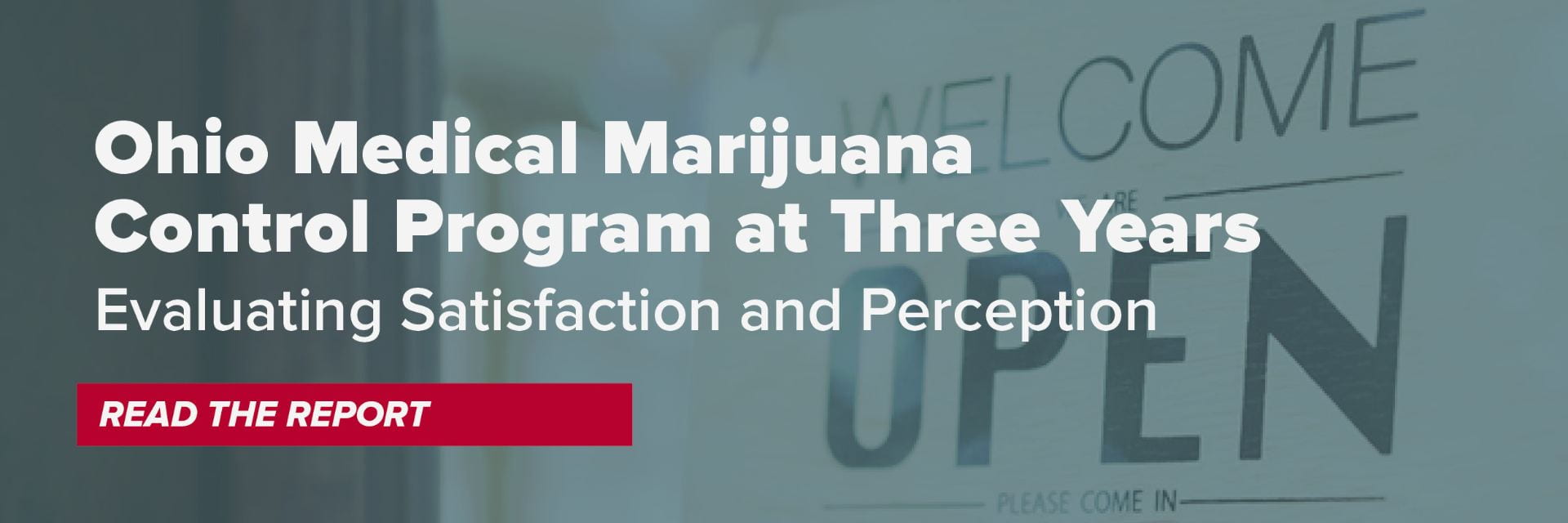2023 Survey Report

This report, a fifth in the annual series from the Drug Enforcement and Policy Center (DEPC), traces the evolution of the Ohio Medical Marijuana Control Program (OMMCP) over the last five years. As in years past, the report provides both information about the growth of OMMCP in respect to sales, sales receipts and taxes collected, as well as survey results focused on OMMCP patients’ and prospective patients’ satisfaction levels with the functioning and design of the program, garnered from over 2900 survey responses. While overall satisfaction levels are rising, patients continue to voice concerns about some aspects of the medical marijuana program, including the price of cannabis products in Ohio dispensaries, lack of legal protections for patients, and the cost and difficulty of obtaining OMMCP patient card. Similar to last year’s report, the final section includes recommendations for policy and regulatory changes that could have a positive impact on patients’ satisfaction with OMMCP. It also provides information on which of these policy recommendations would be addressed should the November 2023 ballot initiative to legalize adult-use cannabis in Ohio pass.
Selected Findings
- Since January 2019, the state of Ohio collected over $132 million in revenue.
- Ohio medical dispensaries recorded a 39.6% increase in year-to-year sales of marijuana plant and 33.9% increase in sales of manufactured products. However, due to falling prices, this translated only in a 10% sales receipt growth and a commensurate 10% increase in collected tax revenue.
- The OMMCP recorded an 18.2% increase in the number of patients with active recommendation and active registration growing from June 2022 to June 2023.
- Despite an average monthly drop of 21.1% in marijuana prices in Ohio dispensaries, marijuana products continue to be more affordable in the state of Michigan.
- Over 90% of patients seeking medical marijuana recommendation go to a specialized doctor whom they see only for this specific purpose.
- For the first time we asked patients to tell us about how much they pay for their annual doctor recommendation they are required to have in order to renew their patient registration. 10% of respondents reported paying $200 or more; and nearly 70% of patients reported being charged $100 or more for the required annual physician recommendation.
- 75% of survey respondents indicated that they purchased 80-100% of their supply from a licensed Ohio dispensary; 25% of respondents indicated that they utilize additional sources for their supply. When asked about why Ohio dispensary was not their primary source of medical marijuana, the most frequently cited reason was the high cost of marijuana in Ohio dispensaries, followed by the cost of obtaining and maintaining a patient card.
- 62.1% of people reporting being either “extremely satisfied” or “somewhat satisfied” with OMMCP, which is an increase of 6 percentage points from last year. Of those satisfied, 43.2% indicated that they are “somewhat satisfied” suggesting that additional improvements to the program are still needed. Only 29.8% of respondents reported being either extremely or somewhat dissatisfied with the program.
- As was the case last year, the policy change that would most positively affect patients’ satisfaction with OMMCP would be the provision of legal protections for employment, housing and firearm privileges with 74.5% of respondents indicating that this policy change would increase their satisfaction considerably. The other two policy changes that would considerably improve people’s satisfaction with OMMCP would be allowing self-cultivation and home delivery.
- Two policy changes would have significant negative repercussions for patients’ satisfaction – no longer allowing virtual medical appointments to obtain a recommendation and not allowing online ordering of medical marijuana with 76.24% and 66% of respondents respectively stating that would decrease their satisfaction with OMMCP considerably.
- 86.6% of respondents reported having trust in the safety of products sold in Ohio dispensaries.
2022 Survey Report

This report, a fourth in the annual series from the Drug Enforcement and Policy Center (DEPC), traces the evolution of the Ohio Medical Marijuana Control Program (OMMCP) over the last four years in terms of its growth and OMMCP patients’ and prospective patients’ satisfaction levels with the functioning and design of the program. For the first time, our survey finds respondents reporting being more satisfied with OMMCP than dissatisfied, an important milestone in OMMCP’s development. Nevertheless, the survey respondents continue to report dissatisfaction with some elements of the program, with the price of marijuana product being the most pressing concern, followed by lack of legal protections for patients and the cost and difficulty of obtaining OMMCP patient card. The final section of this report includes recommendations for policy and regulatory changes that could have a positive impact on patients’ satisfaction with OMMCP.
Selected Findings
- 56.1% of respondents reported some level of satisfaction with OMMCP, with 15.3 % reporting being “extremely satisfied” and 40.8% being “somewhat satisfied.” Only 35.5% of respondents expressed some degree of dissatisfaction with OMMCP, a significant change from last year when 55.1% of people reported being dissatisfied.
- If averaged over the 13 months, an Ohio patient paid $4.08 more per gram of plant product in an Ohio dispensary than a Michigan resident in a Michigan dispensary, and $3.57 less per gram than a marijuana medical patient in Pennsylvania.
- The OMMCP recorded a 44% increase in the number of patients with active recommendation and active registration growing over the past 12 months. But the number of physicians with a certificate to recommend has declined over the same time period to 641 from 651 a year earlier. The patient to doctor ratio in Ohio now represents the lowest among states with a similarly aged program.
- 94% of respondents reported being registered as patients with OMMCP, an increase from 81.5% in last year’s survey. According to patients who do not use medical marijuana, the top two reasons preventing them from using marijuana were the cost of product and the cost and difficulty associated with obtaining a doctor’s recommendation and patient card.
- The top three policy changes that would most positively affect patients’ satisfaction with OMMCP would be the adoption of legal protections for patients, followed by state allowance for self-cultivation, and provision of home delivery under OMMCP.
- Since January 2019, the state of Ohio collected over $132 million in revenue, with the state tax and local tax accounting for approximately $64 million, medical marijuana businesses application and licensing fees accounting for another $46 million and patient and caregiver fees making up the remaining $22 million.
- 84% of respondents reported having trust in the safety of products sold in Ohio dispensaries. Only 7.2% reported not trusting the safety of dispensary products.
2021 Survey Report
Read the third report from the Drug Enforcement and Policy Center (DEPC) which traced the development of the Ohio Medical Marijuana Control Program (OMMCP) since the start of legal sales in January 2019 and documented continued dissatisfaction among patients and prospective patients.
Selected Findings
- 61.6% of respondents reported being “extremely” or “somewhat dissatisfied” with the OMMCP. This is a slight decrease from 67% in 2019. However, the degree of dissatisfaction decreased significantly. 30.2% reported extreme dissatisfaction in this year’s survey compared with 48% in 2019.
- Two main reasons cited for not using medical marijuana: cost and a fear of losing employment.
- 51.5% of respondents with a qualifying condition reported that they currently use marijuana.
- 84.2% of respondents indicated preference for purchasing marijuana from a legal dispensary if marijuana was made fully legal and product was similarly priced to the unregulated market.
- 52.8% of people who reported a qualifying condition and to be currently using marijuana have received a doctor’s recommendation under the OMMCP.
2020 Survey Report
Read the second report from the Drug Enforcement and Policy Center (DEPC) which indicated continued dissatisfaction with the Ohio Medical Marijuana Control Program (OMMCP), primarily based on pricing. The report built on a previous, first-of-its-kind survey conducted in 2019 by DEPC and Harm Reduction Ohio.
Selected Findings
- 61.6% of respondents reported being “extremely” or “somewhat dissatisfied” with the OMMCP. This is a slight decrease from 67% in 2019. However, the degree of dissatisfaction decreased significantly. 30.2% reported extreme dissatisfaction in this year’s survey compared with 48% in 2019.
- Two main reasons cited for not using medical marijuana: cost and a fear of losing employment.
- 51.5% of respondents with a qualifying condition reported that they currently use marijuana.
- 84.2% of respondents indicated preference for purchasing marijuana from a legal dispensary if marijuana was made fully legal and product was similarly priced to the unregulated market.
- 52.8% of people who reported a qualifying condition and to be currently using marijuana have received a doctor’s recommendation under the OMMCP.
DEPC revised this report on October 6, 2020 and added an addendum.
2019 Survey Report

Read the report from the preliminary 2019 online survey conducted by DEPC and Harm Reduction Ohio.

